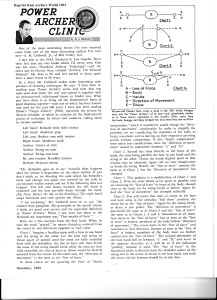I asked that question of some of our JOAD students and got a variety of answers. What surprised me more, was what was not in the quiver of some adult shooters with more experience.
Ok, the short answer first. Carry everything you need to effect minor to moderate repairs to your equipment and you, as well as necessary items to participate in a tournament
Now let’s drill down to some specifics. Yeah, well……….arrows. But you would be surprised at the number of shooters who only carry the minimum number required to shoot an end. Stuff happens. Whether it is a lost arrow, or breakage, have a few spares in your quiver and ready access to more arrows if needed. Remember, a broken arrow does not constitute an equipment failure.
1) Tab – Carry at least one spare tab. (Make sure you have used and broken it in!!) Tournaments do not stop because of rain. Shooting with a dry tab is an edge.
1A) Release – What are you going to do if your primary release breaks?????? Have another and be familiar with it. Often times shooters will carry 2 types of releases, depending upon shooting conditions. (windy=thumb, calm=hinge)
2) Finger sling – They have a tendency to get lost easily. Carry a couple of spares; they take little space in your quiver
3) Nocks – It would seem obvious, but……….. And know the proper way to index a nock and either adhere, or press fit them.
4) Arrow puller – Whitetail target butts, need I say more? Find a place on the exterior of your quiver to clip it.
5) Arrow lubricant – It can be as simple as a bar of soap or clear shoe polish, to specifically manufactured products. When you need arrow lube, you’ll be thankful it is in your quiver.
6) Arrow rest – Who wants their tournament to end because of a broken rest? This is another item which takes little space in your quiver.
7) Allen wrenches – Look at what is on your bow which would need to be tightened, or adjusted. I carry both a metric and SAE version. Try to get as compact a set as possible.
8) Multi Tool – Very handy for doing a variety of tasks, from cutting serving to extracting points.
9) A length of serving thread – Tying off an unraveling serving, or tying in a nocking point on the fly has saved my bacon on more than one occasion.
10) Spare string – It’s insurance and takes little room. Again this should be a string you’ve broken in and have nocking points affixed to it.
11) Pencils and calculator – It’s tough to score without a pencil! And the calculator…let me say Rick McKinney feels more comfortable when I’m using one!
I carry everything on the above list, except for extra releases. (I primarily shoot Olympic recurve these days.) On the compound end, I would carry a hood for my scope in case of rain. A spare peep, some D-loop material and other compound specific items.
There could be additional things you find handy and by all means add to the list! What I have tried to do is anticipate what my needs will be in a tournament. My list has expanded based on my experiences. I hope the list serves you well.


